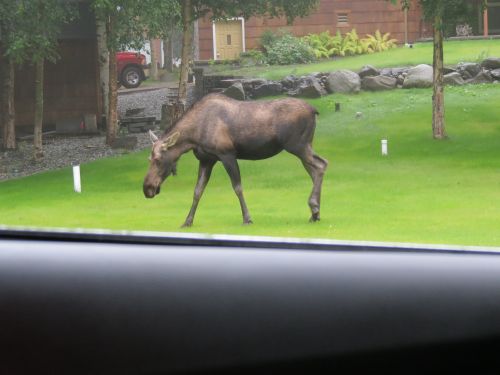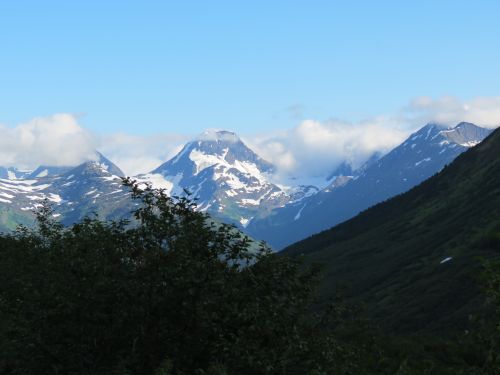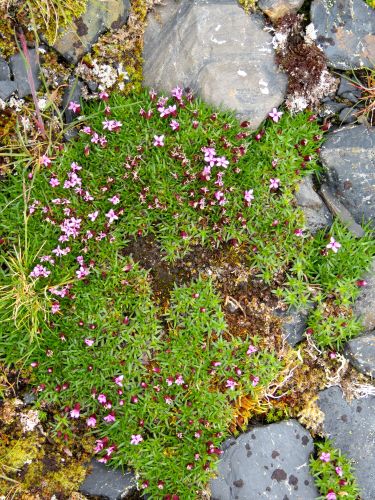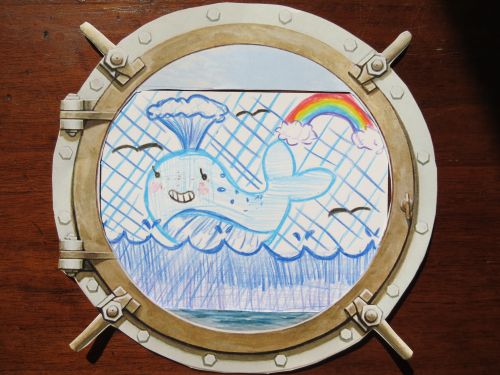Anchorage Arrival!
After a great night’s sleep following a very long day of traveling, research scientist Dr. Robert Campbell and I headed out to meet Dr. Steve Okkonen for a day hike up to Crow Pass in Chugache National Forest. A funny thing happened on the way to the mountain! As we were driving along, we took what appeared to be a wrong turn. However sometimes, a wrong turn can turn out to be the right turn, and this was the case today! What a surprise to see two moose grazing near the side of the road!
 Moose sighting off the port side of our car while driving around Anchorage Alaska. Photo by Lisa Seff. August 21, 2012.
Moose sighting off the port side of our car while driving around Anchorage Alaska. Photo by Lisa Seff. August 21, 2012.
 One moose, two moose! Photo by Lisa Seff. August 21, 2012.
One moose, two moose! Photo by Lisa Seff. August 21, 2012.
 The moment the moose became interested in our little blue car! Photo by Lisa Seff. August 21, 2012.
The moment the moose became interested in our little blue car! Photo by Lisa Seff. August 21, 2012.
They were enormous and beautiful to watch, but not for long as they stopped grazing and began to stroll directly toward our, getting smaller by the second, Ford Focus! Wondering if our insurance would cover moose tracks we breathed a sigh of relief as they calmly shifted their course, turning slightly in front of the car, instead of over it!
 Moose crossing! Anchorage Alaska. Photo by Lisa Seff. August 21, 2012.
Moose crossing! Anchorage Alaska. Photo by Lisa Seff. August 21, 2012.
Alaska Wildlife Conservation Center
We then headed to the Alaska Wildlife Conservation Center located in Girdwood, just south of Anchorage. It was pretty hard to beat our wandering moose encounter, but we enjoyed seeing the various Alaskan wildlife, many of which were rescue animals that now either make the Center their permanent home, or may eventually be returned to the wild.
 Nice day for a dip! Brown Bear swimming in the Alaska Wildlife Conservation Center. August 21st, 2012. Photo by Lisa Seff.
Nice day for a dip! Brown Bear swimming in the Alaska Wildlife Conservation Center. August 21st, 2012. Photo by Lisa Seff.
 Nice day for a snooze! Lynx sisters napping in the Alaska Wildlife Conservation Center. August 21st, 2012. Photo by Lisa Seff.
Nice day for a snooze! Lynx sisters napping in the Alaska Wildlife Conservation Center. August 21st, 2012. Photo by Lisa Seff.
 Are you looking at me? Another moose checking us out at the Alaska Wildlife Conservation Center. August 21st, 2012. Photo by Lisa Seff.
Are you looking at me? Another moose checking us out at the Alaska Wildlife Conservation Center. August 21st, 2012. Photo by Lisa Seff.
Crow Pass!
For our final adventure of the day we met up with Dr. Okkonen at the edge of Chugache State Park and followed him to the entrance of Crow Pass.
 Entering the Chugach National Forest. August 21st, 2012. Photo by Lisa Seff.
Entering the Chugach National Forest. August 21st, 2012. Photo by Lisa Seff.
What a hike! I’m learning that Alaskans always do things in a BIG way and today’s hike was no exception! We went up, and up, and up and up, across all types of terrain, some of which seemed at times more appropriate for mountain goats then humans!
 Pausing to look back down the trail as we hiked up the mountain to Crow Pass in Chugach National Forest. August 21st, 2012. Photo by Lisa Seff.
Pausing to look back down the trail as we hiked up the mountain to Crow Pass in Chugach National Forest. August 21st, 2012. Photo by Lisa Seff.
Did I mention we went up? Pictures just can’t do the scenery or the steepness of the slopes, justice. At times along the trail I wondered if I would make it, but the combination of great trail companions, Reeses Peanut Butter Cups, stunning vistas beautiful wildflowers, and of course the final grand prize of a close-up view of a glacier made the trip a joyful experience.
 Distant mountain views along the trail as we hiked up the mountain to Crow Pass in Chugach National Forest. August 21st, 2012. Photo by Lisa Seff.
Distant mountain views along the trail as we hiked up the mountain to Crow Pass in Chugach National Forest. August 21st, 2012. Photo by Lisa Seff.
 Wildflowers along the trail as we hiked up the mountain to Crow Pass in Chugach National Forest. August 21st, 2012. Photo by Lisa Seff.
Wildflowers along the trail as we hiked up the mountain to Crow Pass in Chugach National Forest. August 21st, 2012. Photo by Lisa Seff.
 Wildflowers along the trail as we hiked up the mountain to Crow Pass in Chugach National Forest. August 21st, 2012. Photo by Lisa Seff.
Wildflowers along the trail as we hiked up the mountain to Crow Pass in Chugach National Forest. August 21st, 2012. Photo by Lisa Seff.
So how was the final view at the top? WOW. It was awesome! Standing high on the lateral moraine looking across the crevasses in the stunningly blue glacial ice was truly an inspirational moment and definitely worth the trip!
 Glacier at Crow Pass in Chugach National Forest. August 21st, 2012. Photo by Lisa Seff.
Glacier at Crow Pass in Chugach National Forest. August 21st, 2012. Photo by Lisa Seff.
 The blue ice of the glacier at the top of Crow Pass in Chugach National Forest. August 21st, 2012. Photo by Lisa Seff.
The blue ice of the glacier at the top of Crow Pass in Chugach National Forest. August 21st, 2012. Photo by Lisa Seff.
 PolarTREC educator Lisa Seff with research scientists Dr. Robert Campbell and Dr. Steve Okkonen (left to right) at the top of Crows Pass in Chugach National Forest with the glacier behind us. August 21st, 2012. Photo by travelers along the way.
PolarTREC educator Lisa Seff with research scientists Dr. Robert Campbell and Dr. Steve Okkonen (left to right) at the top of Crows Pass in Chugach National Forest with the glacier behind us. August 21st, 2012. Photo by travelers along the way.
Tomorrow we’re up at 4am to head back to the airport to fly up to Prudhoe Bay where we’ll load our research vessel Ukpik for our expedition! Can’t wait to see what the day brings! Stay tuned!
Through the Porthole: How did the bowhead whale get it’s name?
 Through the Porthole whale drawing. Whale drawing by Springs School Student Hunter. Photo by Lisa Seff.
Through the Porthole whale drawing. Whale drawing by Springs School Student Hunter. Photo by Lisa Seff.
Like all living organisms on Earth the bowhead whale has a common name and a scientific name. The common name of bowhead, comes from the whales large arched lower jawbone, that with a little imagination looks like an archer’s bow. The scientific name, or genus and species, Balaena mysticetus, translates to a mustached whale (balaena and cetus=whale, mysti=mustached). The mustache refers to the hundreds of baleen plates made of keratin that hang down inside the whale's mouth. To eat, the bowhead whale skims through the ocean filling it’s mouth with seawater and small organisms. As the whale forces the water back out, the hundreds of baleen plates act like a giant sieve, trapping ocean dwelling microorganisms, including zooplankton called krill, inside the whales mouth.
Dinner is served!

